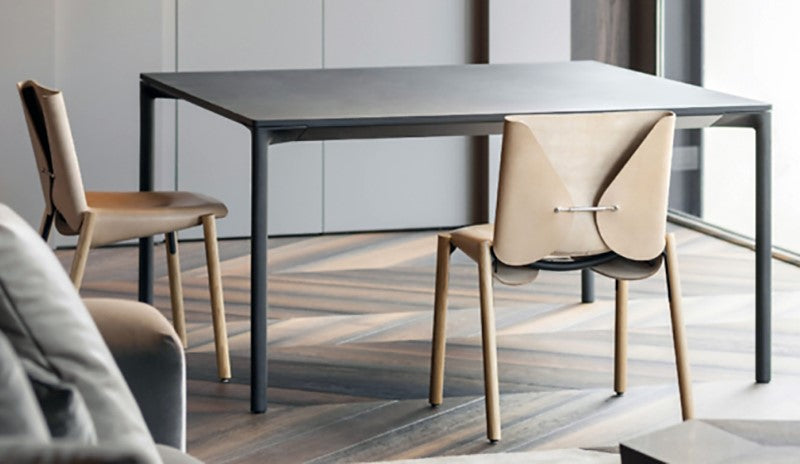
Are Leather Dining Chairs a Good Idea? Let’s Break It Down
Leather has a reputation - timeless, polished, a little formal. But when it shows up in a dining room, it can offer something quieter: comfort with structure, and a finish that gets better with age.
We’ve seen a growing interest in leather dining chairs, especially as more clients move toward natural materials and long-term design choices. But that doesn’t make it a universal fit. Choosing leather is less about following a trend and more about understanding how it fits into your space, lifestyle, and daily use expectations.
In this guide, we’ll break down the pros and cons of leather dining chairs, focusing on real leather, so you can make an informed decision that feels right for your home.
Why Leather Dining Chairs Are Worth Considering
A well-made leather dining chair doesn’t just look good; it holds up. That matters in spaces that get daily use. Real leather is durable, easy to maintain, and naturally resistant to most spills and stains, especially if addressed quickly.
We’ve seen leather perform especially well in open-plan homes, where the dining area flows directly from the kitchen or living room. It helps define the space with a quiet kind of texture, one that doesn’t compete with other finishes but adds a tactile layer that holds its own.
“Generally, genuine leather is lauded for its durability and longevity; it’s only going to look better with age and some patina.” - Architectural Digest
That kind of aging, where the material softens, darkens slightly, and picks up subtle character, is part of what makes leather a smart investment for high-use spaces.

What leather does well compared to upholstered chairs:
-
Wipes clean easily, no deep scrubbing required
-
Ages into a natural patina over time
-
Holds structure better than most fabrics
-
Doesn’t trap allergens or dust
-
Works across a wide range of interior styles
If you're furnishing a space with shared daily functions - meals, laptop time, maybe even the occasional art project - leather dining chairs can keep up without looking worn out. In high-traffic areas, we often recommend top-grain leather for its balance of softness and resilience.
When Leather Might Not Be the Right Fit
That said, leather isn't always the most practical choice, and it’s worth calling that out.
If you have pets that are rough on furniture, leather can show wear in the form of scratches. It also isn’t ideal for homes with young children who are still learning how to eat without finger-painting the table. And while leather does adapt to temperature, it can feel cold in the winter or sticky in the summer, particularly in rooms without proper climate control.
When we recommend clients upholstered dining chairs:
-
You need extra softness or a more cushioned seat
-
You live in an environment with extreme seasonal changes
-
You’re looking for washable or slipcovered options
-
You prefer pattern or texture over a solid material finish
In these situations, fabric upholstery offers more variety and a wider range of touch and tone, especially useful in formal dining rooms or when layering in textiles.
Maintenance: What Modern Dining Room Chairs Actually Require
Leather doesn’t need a lot, but what it does need, it needs consistently. Regular wiping and occasional conditioning go a long way. Unlike fabric, there’s no need for steam-cleaning or lint rollers. But it’s important to avoid harsh cleaners or over-saturating the material.
Basic care tips:
-
Wipe down with a dry cloth weekly
-
Clean spills immediately with a damp (not wet) cloth
-
Use a leather conditioner every 3-6 months to prevent drying or cracking
-
Avoid placing near direct sunlight or heating vents
We often recommend leather-safe brands for clients looking to maintain their chairs over time. A small investment in proper care can extend the life of the material significantly.
Can Leather Dining Chairs Work in Color?
They can and often work better because of it. While black and brown leather still anchor many spaces, color has become a quiet tool for creating dimension, warmth, or softness. The shift isn’t toward bold hues but toward nuanced tones that support the rest of the room without dominating it.
We’ve seen colored leather chairs used effectively in both modern and transitional homes, often as a way to layer contrast or bring in material variation when everything else leans clean or minimal.

Joe S L TS Side Chair by Midj
This fully upholstered side chair is available in both Vintage Leather and Fiore full-grain leather, offering a wide range of hand-aged European tones.
-
Fiore Leather includes options like Light Blue Sky, Terracotta, Ivory, and Moss Green
-
Vintage Leather offers more muted shades like Denim Blue, Olive, and Warm Sand
-
Both finishes wear in beautifully and develop character over time
We’ve specified the Joe Chair in Vintage Denim Blue for loft dining rooms with concrete floors and dark metal fixtures. It adds a cool tone without competing with the architecture, a small shift that changes the entire mood of the room.
Suite P L CU Leather Armchair by Midj
Crafted with a hide leather seat and a solid wood frame, the Suite P L CU brings natural material depth in a clean, sculptural form.
-
Seat and back in Italian hide leather
-
Base in wood - available in walnut, oak, and lacquered finishes
-
Offered in rich tones like ash grey, natural tan, and dark brown
We’ve specified this chair in natural tan hide for open dining rooms that connect to warm-toned kitchens. It brings cohesion without feeling matchy and the wood base reinforces the organic material story.
The takeaway:
-
Use warmer leather tones (tan, rose, camel) to bring in softness
-
Choose cooler hues (sage, grey, slate) to complement stone or concrete
-
Consider upholstery if you want access to a wider fabric palette while still prioritizing comfort

Final Thoughts
So, are leather dining chairs a good idea?
In the right space, absolutely. They offer long-term durability, easy maintenance, and a finished look that complements both modern and transitional interiors. But they aren’t the most forgiving option in every household.
If your home calls for flexibility, softness, or more color variation, fabric upholstery might serve you better. But if you want something that can work hard and age well, real leather earns its place at the table.
Related Posts You Might Like
-
The Art of Pairing Designer Dining Room Chairs With Your Table
Explore what sets a true designer chair apart, from materials to form and how they actually perform in a real dining setting. We break down the details that matter most.
-
How Many Chairs Fit Around My Table?
Find practical tips on table sizing and spacing, based on shape, use, and available room. -
How to Choose a Dining Table Light Fixture
The wrong lighting can make even the best table feel flat. Here’s how to choose a fixture that brings balance, proportion, and intention to your dining zone.


